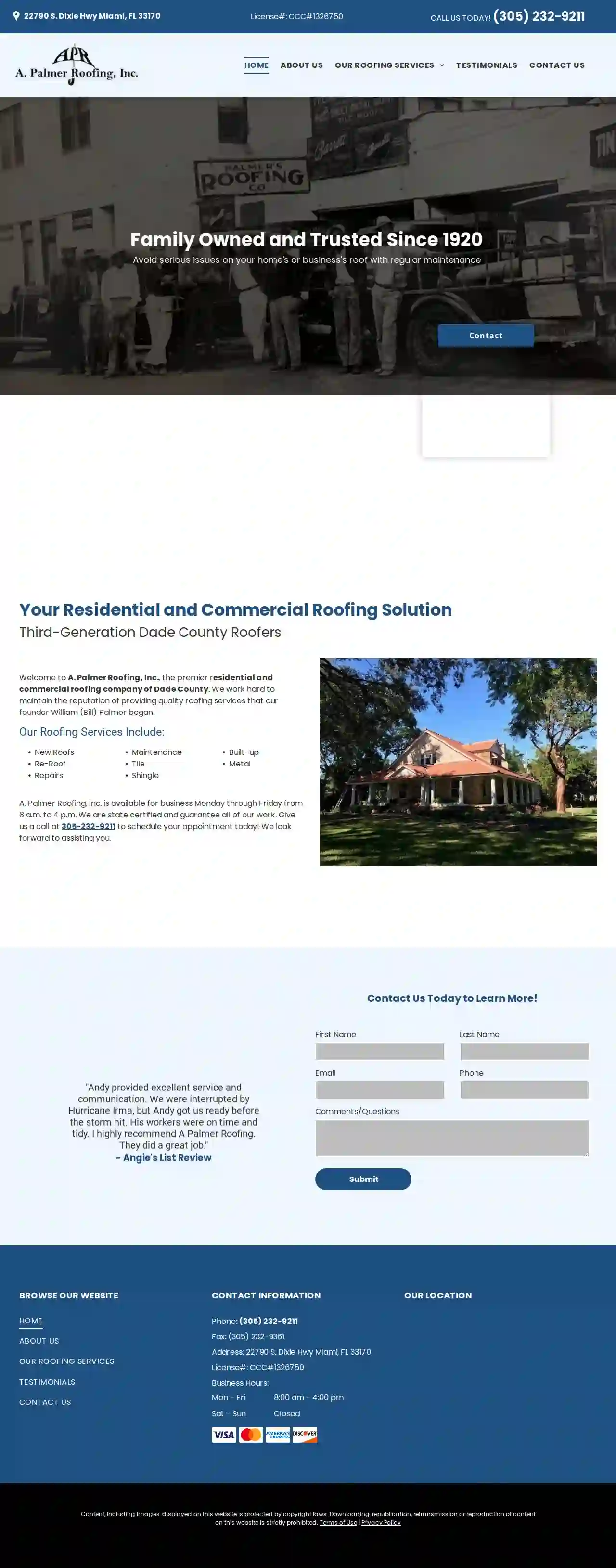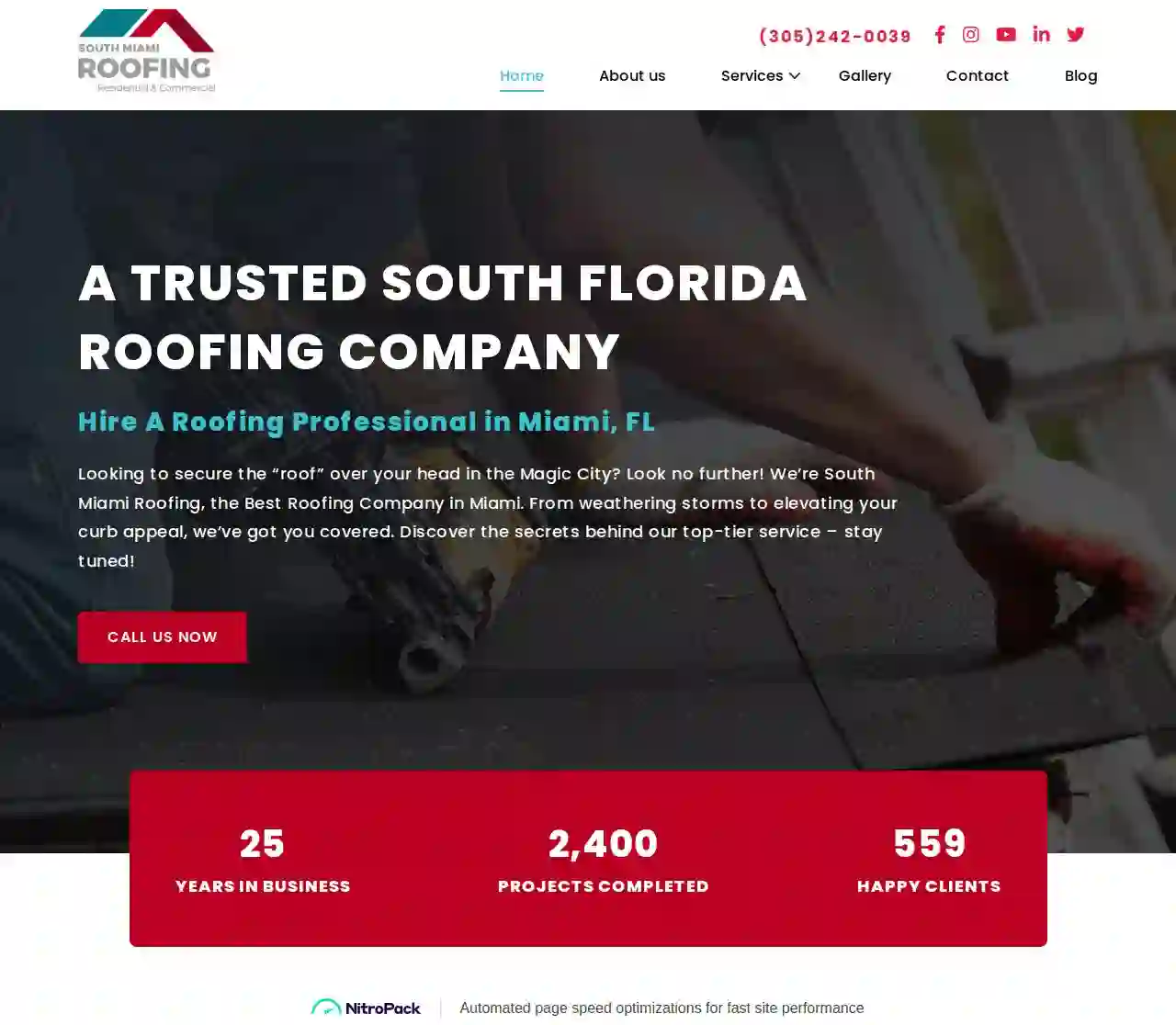Roofing Companies Suncoast Estates
Find top Roofing Service in Suncoast Estates
Receive 3 FREE Roofing Contractor quotes for your project today! Compare profiles, reviews, accreditations, portfolio, etc... and choose the best deal.

A Palmer Roofing
52 reviews22790 S. Dixie Hwy, Miami, 33170, USFamily Owned and Trusted Since 1920 Avoid serious issues on your home's or business's roof with regular maintenance Superior Workmanship & Quality Materials We specialize in residential and commercial roofing solutions throughout Dade County Family Owned and Trusted Since 1920 With a reputation for quality, you can trust our licensed team to take care of your roof. Our Roofing Services Include: New Roofs Re-Roof Repairs Maintenance Tile Shingle Built-up Metal A. Palmer Roofing, Inc. is available for business Monday through Friday from 8 a.m. to 4 p.m. We are state certified and guarantee all of our work. Give us a call at 305-232-9211 to schedule your appointment today! We look forward to assisting you.
- Services
- Why Us?
- Testimonials
- Gallery
Get Quote
Assure-U Roofing
4.833 reviews3236 Scallion Court, Orlando, 32825, USWe know how important everything under your roof is. That's why we respect it as if we live under it. Get In Touch! Orlando's roofing company since 2004. Proudly serving Orlando, Maitland, Longwood, Kissimmee and surrounding areas. Welcome to Assure-U Roofing, your premier source for high-quality roofing services in Orlando and the surrounding areas. With multiple decades of experience and a team of experts, we're committed to providing our customers with top-notch roofing solutions that are tailored to meet your unique needs and budget. At Assure-U Roofing, You Are The Priority. At Assure-U Roofing, we strive to provide superior service and long-lasting results — without impacting your daily life. From the initial phone call to final inspection, our friendly, local team is committed to working with you to find, communicate, and deliver a roofing solution to fit your needs and schedule. Stress Free Roofing Services. Roofing services. We are state licensed roofing contractors in Florida and do all roofing repairs from storm damage to maintenance services on architectural shingle roofs, flat roofs or metal roofs. Our company offers roof inspections for residential homes. Contact us today to learn more about our roofing repairs. Read our testimonials from satisfied customers. Commercial Roofing Services. Skylights & Solar Attic Fans. Our licensed roofing contractors in Orlando can repair and install skylights and solar attic vents that are energy efficient. These fans reduce the temperature of the attic, and our skylights will give you a natural light. They come in either plastic or glass and feature a tubular design. Common problems we repair are leaks around the existing skylights and attic fans. Assuring your peace of mind every step of the way.
- Services
- Why Us?
- Accreditations
- Our Team
- Testimonials
- Gallery
Get Quote
South Miami Roofing
52 reviews6800 SW 40th St. Suite #668, Miami, 33155, USA TRUSTED SOUTH FLORIDA ROOFING COMPANY Hire A Roofing Professional in Miami, FL Looking to secure the “roof” over your head in the Magic City? Look no further! We’re South Miami Roofing, the Best Roofing Company in Miami. From weathering storms to elevating your curb appeal, we’ve got you covered. Discover the secrets behind our top-tier service – stay tuned! CALL US NOW 25 YEARS IN BUSINESS 2,400 PROJECTS COMPLETED 559 HAPPY CLIENTS Looking for the Best Roofing Company in Miami, FL South Miami Roofing is your go-to roofing company in Miami, Florida. We take care of the re-roof, roof repair, and maintenance of your metal, tile, flat, and shingle roof. All of our products carry a limited lifetime warranty.
- Services
- Why Us?
- Gallery
Get Quote
Florida Building Pros Inc.
4.861 reviewsCape Coral, USFlorida's Favorite Roofer is a roofing company based in Cape Coral, FL, serving all of South Florida. We are dedicated to providing unparalleled roofing and customer service. Our management team oversees over 100 qualified staff and dozens of crews, representing over ten years of roofing experience. Homeowners, realtors, and property owners trust us for their roofing needs. We prioritize quality materials and offer a variety of options, including metal, architectural shingles, flat roofs, and tile. We understand the importance of storm protection in Florida and specialize in helping homeowners prepare for potential damage. Our team is committed to guiding you through the process, from choosing the right materials to ensuring a successful installation. We invite you to browse our gallery to see examples of our work and request a complimentary roofing inspection today.
- Services
- Why Us?
- Accreditations
- Gallery
Get Quote
Titan Roofing Company
54 reviews4115 W Spruce St #200, Tampa, 33607, USTitan Roofing Company is dedicated to being the best in the Tampa Bay area roofing industry by providing our clients with the finest quality of work, leading products in the market, and superior customer service. We provide quality roofing services to homeowners and business owners throughout the Tampa Bay area. Our roofing repair contractors specialize in roof replacement and new roof installation projects, and are recognized as one of the leading residential roofing companies in the Tampa Bay area. We also offer commercial roofing services, installing roofing systems on schools, municipal buildings, retail and other industrial structures. Additionally, we provide storm and damage repair services, accurately identifying and offering sensible solutions to leaks and other storm or damage issues that need repair.
- Services
- Why Us?
- Accreditations
- Gallery
Get Quote
CMP Building Products
59 reviews3416 Garber Drive, Tallahassee, 32303, USWelcome to CMP Building Products, a family-owned business serving the area with quality building products since 1985. We provide a wide range of products, including screen rooms, awnings, metal roofing, gutter material, soffit and siding, screen doors and pool enclosures, windows, aluminum columns, fencing, handrails, and more. We also connect you with quality, licensed contractors who can provide free estimates. Whether you're a contractor or a homeowner, we're dedicated to making you happy. We give everyone our full attention, no matter how big or small your order is. Give us a call! We specialize in custom-bending and cutting sheet metal to your specifications. Our full sheet metal shop allows us to create custom shapes and lengths. We also use our portable gutter machine to run gutters to your desired length. Have questions about rentals, recurring orders, or need help finding something? Don't hesitate to reach out. We'll get back to you as soon as possible.
- Services
- Why Us?
- Our Team
- Gallery
Get Quote
HomeShield Roofing
562 reviewsOrlando, FL, 1517 S. Crystal Lake Dr, 32806, USAt HomeShield Roofing, we understand the importance of a safe and reliable roof for your home. We are your trusted roofing experts, dedicated to providing top-quality roofing solutions that protect your home, enhance its beauty, and provide peace of mind for years. With years of industry experience and a team of skilled professionals, we specialize in roofing services, including installations, replacements, and maintenance. Whether you have a residential or commercial property, we have the expertise and resources to handle projects of all sizes and complexities. Our commitment to excellence is evident in every aspect of our work. We use only the finest materials sourced from trusted manufacturers to ensure the durability and longevity of your roof. Our skilled roofing technicians are trained to deliver exceptional craftsmanship, paying attention to every detail to ensure a flawless finish. We are proud to provide quality roofing services to all of Central Florida. Orange, Seminole, Lake, Osceola, Brevard, Polk, Volusia. We understand that every customer is unique, and we take the time to listen to your requirements and provide customized solutions. Our team consists of highly trained and experienced roofing professionals passionate about delivering exceptional results. We believe in using only the highest-quality materials to ensure the longevity and performance of your roof. From installations and repairs to replacements and maintenance, we offer a wide range of services to meet all your roofing needs. Our priority is your satisfaction. We strive to exceed your expectations by delivering superior craftsmanship and exceptional services.
- Services
- Why Us?
- Accreditations
- Our Team
- Testimonials
- Gallery
Get Quote
Covelli Roofing
4.736 reviews318 Specialty Point, Sanford, 32771, USCovelli Roofing and Contractors LLC have been repairing, installing, and replacing roofs for over 10 years. We guarantee our work and offer a five-year labor/workmanship warranty on all our services. Trust our veteran-owned and operated business to do an outstanding job for you. Our roofing company is committed to doing top-quality work. We hire only those who are skilled at installing different types of roofing materials. You can count on us when you need roofing services because: We work on residential properties We work with property management companies We’ll do a follow-up visit after the service is complete We have over 10 years of experience installing and repairing roofs. Hire our roofing contractors to repair, replace or install your new roof, and put your mind at ease.
- Services
- Why Us?
- Accreditations
- Gallery
Get Quote
RL Spencer Roofing
54 reviews2501 6th Ave S, St. Petersburg, 33712, USRL Spencer Roofing is a family-owned and operated roofing company serving Southwest Florida since 2006. We are a licensed and insured contractor specializing in residential and commercial roofing, windows, and gutter services. Our team of highly skilled experts is dedicated to providing high-quality workmanship and personalized service. We are committed to exceeding our clients' expectations and offer a 10-Year Workmanship Warranty on all our jobs. We work with reputable brands and manufacturers to ensure our customers receive the best products and services. We also offer competitive pricing, including a 5% Senior and Veterans Discount.
- Services
- Why Us?
- Accreditations
- Our Team
- Testimonials
- Gallery
Get Quote
Legend Roofing
55 reviews11515 Pyramid Dr, Odessa, 33556, USThe Leading Roofing Company in Tampa Bay, FL We’ve got you covered. = A+ Better Business Accreditation = Affordable Financing Options = Product and Workmanship Warranties Schedule an Appointment with a Roof Expert Get Your Free Instant Roof Estimate Here Legend Roofing is Your Trusted Local Roofing Contractor Our team of experienced roofers will work with you to find the best roofing solution for your home or business. We specialize in roof repair and replacement, and can also help with storm damage and maintenance. We are licensed and insured with over three decades of experience in the industry, so you can be sure that your roof is in good hands. We pride ourselves on our commitment to customer satisfaction, and strive to provide the best quality service and workmanship in the industry. We use only the highest quality materials and craftsmanship backed by industry-leading manufacturer warranties and our own personal workmanship warranty. We want you to feel confident that you’re getting the best roofing service available in Tampa, FL and beyond. If you’re looking for an experienced roofing contractor that you can trust, look no further than Legend Roofing. Contact us today to learn more about our services and to schedule a free estimate.
- Services
- Why Us?
- Accreditations
- Gallery
Get Quote
Over 17,196+ Roofing Companies on our platform
Our roofing experts operate in Suncoast Estates and beyond!
Roofyng.com has curated and vetted Top Roofers near Suncoast Estates. Find a reliable business today.
Frequently Asked Questions About Roofing Companies
- Sagging or Pulling Away: Gutters that are sagging, pulling away from the house, or visibly damaged need repairs or replacement.
- Overflowing Water: If water overflows during rain, it indicates clogs or inadequate drainage.
- Visible Debris: Leaves, twigs, and other debris accumulated in the gutters obstruct water flow.
- Water Damage: Water stains or damage to siding or foundation near the gutters suggest overflow.
- Plant Growth: Plants or moss growing in the gutters indicate standing water and the need for cleaning.
- Choose Reflective Roofing Materials: Opt for light-colored shingles or metal roofing that reflects sunlight and reduces heat absorption.
- Install Proper Attic Insulation: Adequate insulation prevents heat loss in the winter and heat gain in the summer.
- Ensure Adequate Ventilation: Proper attic ventilation allows hot air to escape, reducing cooling costs and extending the lifespan of your roof.
- Consider a Radiant Barrier: In hot climates, a radiant barrier installed in the attic can reflect heat away from the roof, further reducing cooling needs.
- Roof size and complexity
- Roofing material chosen
- Local labor costs
- Accessibility of the roof
- Removal of existing roofing
- Additional features (skylights, chimneys, etc.)
How can I tell if my gutters need to be cleaned or repaired?
What is a roof valley, and why is it important?
How can I make my new roof more energy-efficient?
How much does a new roof cost in the USA?
How can I tell if my gutters need to be cleaned or repaired?
- Sagging or Pulling Away: Gutters that are sagging, pulling away from the house, or visibly damaged need repairs or replacement.
- Overflowing Water: If water overflows during rain, it indicates clogs or inadequate drainage.
- Visible Debris: Leaves, twigs, and other debris accumulated in the gutters obstruct water flow.
- Water Damage: Water stains or damage to siding or foundation near the gutters suggest overflow.
- Plant Growth: Plants or moss growing in the gutters indicate standing water and the need for cleaning.
What is a roof valley, and why is it important?
How can I make my new roof more energy-efficient?
- Choose Reflective Roofing Materials: Opt for light-colored shingles or metal roofing that reflects sunlight and reduces heat absorption.
- Install Proper Attic Insulation: Adequate insulation prevents heat loss in the winter and heat gain in the summer.
- Ensure Adequate Ventilation: Proper attic ventilation allows hot air to escape, reducing cooling costs and extending the lifespan of your roof.
- Consider a Radiant Barrier: In hot climates, a radiant barrier installed in the attic can reflect heat away from the roof, further reducing cooling needs.
How much does a new roof cost in the USA?
- Roof size and complexity
- Roofing material chosen
- Local labor costs
- Accessibility of the roof
- Removal of existing roofing
- Additional features (skylights, chimneys, etc.)